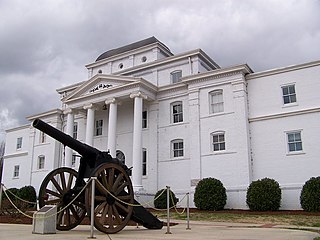
Wilkes County is a county located in the U.S. state of North Carolina. It is a part of the state's western mountain region. As of the 2020 census the population was 65,969. Its county seat is Wilkesboro, and its largest community is North Wilkesboro. Wilkes County comprises the North Wilkesboro, NC Micropolitan Statistical Area.

Roan Mountain is a census-designated place (CDP) in Carter County, Tennessee, United States. The population was 1,360 at the 2010 census. It is part of the Johnson City Metropolitan Statistical Area, which is a component of the Johnson City–Kingsport–Bristol, TN-VA Combined Statistical Area – commonly known as the Tri-Cities region.

Appalachia is a geographic region located in the central and southern sections of the Appalachian Mountains of the eastern United States. It stretches from the western Catskill Mountains of New York state into Pennsylvania, continuing on through the Blue Ridge Mountains and Great Smoky Mountains into northern Georgia and Alabama. In 2021, the region was home to an estimated 26.3 million people, of whom roughly 80% were white.

Old-time music is a genre of North American folk music. It developed along with various North American folk dances, such as square dancing, clogging, and buck dancing. It is played on acoustic instruments, generally centering on a combination of fiddle and plucked string instruments, most often the banjo, guitar, and mandolin. Together, they form an ensemble called the string band, which has historically been the most common configuration to play old-time music. The genre is considered a precursor to modern country music.
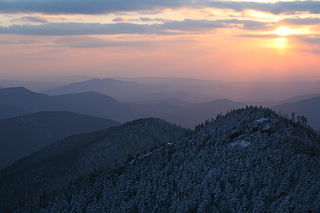
The Great Smoky Mountains are a mountain range rising along the Tennessee–North Carolina border in the southeastern United States. They are a subrange of the Appalachian Mountains and form part of the Blue Ridge Physiographic Province. The range is sometimes called the Smoky Mountains, and the name is commonly shortened to the Smokies. The Smokies are best known as the home of the Great Smoky Mountains National Park, which protects most of the range. The park was established in 1934 and, with over 11 million visits per year, is the most visited national park in the United States.
"Tom Dooley" is a traditional North Carolina folk song based on the 1866 murder of a woman named Laura Foster in Wilkes County, North Carolina by Tom Dula. One of the more famous murder ballads, a popular hit version recorded in 1958 by The Kingston Trio reached No. 1 on the Billboard Hot 100 singles chart, was in the top 10 on the Billboard R&B chart, and appeared in the Cashbox Country Music Top 20.
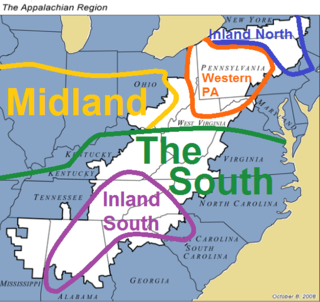
Appalachian English is American English native to the Appalachian mountain region of the Eastern United States. Historically, the term Appalachian dialect refers to a local English variety of southern Appalachia, also known as Smoky Mountain English or Southern Mountain English in American linguistics. This variety is both influential upon and influenced by the Southern U.S. regional dialect, which has become predominant in central and southern Appalachia today, while a Western Pennsylvania regional dialect has become predominant in northern Appalachia, according to the 2006 Atlas of North American English (ANAE). The ANAE identifies the "Inland South,” a dialect sub-region in which the Southern U.S. dialect's defining vowel shift is the most developed, as centering squarely in southern Appalachia: namely, the cities of Knoxville and Chattanooga, Tennessee; Birmingham and Huntsville, Alabama; and Asheville, North Carolina. All Appalachian English is rhotic and characterized by distinct phonology, morphology, syntax, and lexicon. It is mostly oral but its features are also sometimes represented in literary works.
Thomas C. Dula was a former Confederate soldier who was convicted of murdering Laura Foster. National publicity from newspapers such as The New York Times turned Dula's story into a folk legend. Although Laura was murdered in Wilkes County, North Carolina, Dula was tried, convicted, and hanged in Statesville. Considerable controversy surrounded the case. In subsequent years, a folk song was written, and many oral traditions were passed down, regarding the sensational occurrences surrounding Laura Foster's murder and Dula's subsequent execution. The Kingston Trio recorded a hit version of the murder ballad in 1958.

Appalachian music is the music of the region of Appalachia in the Eastern United States. Traditional Appalachian music is derived from various influences, including the ballads, hymns and fiddle music of the British Isles, the African music and blues of early African Americans, and to a lesser extent the music of Continental Europe.

Roan Mountain State Park is a Tennessee state park in Carter County, in Northeast Tennessee. It is close to the Tennessee-North Carolina border and near the community of Roan Mountain, Tennessee. Situated in the Blue Ridge of the Appalachian Mountains, the park preserves 2,006 acres (8.12 km2) of mostly hardwood forest. The park is in close proximity to 6,285-foot (1,916 m) Roan Mountain and the Appalachian Trail, both of which are owned and managed by the US Forest Service. On exceptionally clear days, the Charlotte skyline can be photographed from the peak. Most of the town of Roan Mountain is privately owned by the residence, and much of the land in Roan Mountain has been family owned for many generations, being passed down generation after generation through the years.
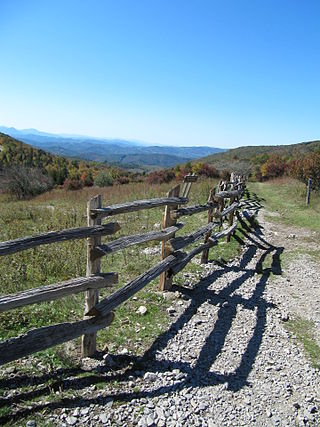
Grayson Highlands State Park is a state park located in Grayson County, Virginia, United States. It is adjacent to the Mount Rogers National Recreation Area and lies within the Jefferson National Forest. The park was established in 1965 and contains a total of 4,502 acres (1,822 ha). The park hosts a number of outdoor activities including hiking, camping, mountainbiking, horseback riding, and backpacking. A 2.8 mile (4.5 km) portion of the Appalachian Trail runs through the park in addition to a number of other hiking and horseback riding trails. The state park is musically notable as the home for the Grayson Highlands Fall Festival as well as weekly jam sessions by local folk musicians, who draw upon the traditional styles of the Blue Ridge area. The park is also home to the Wayne C. Henderson Festival and Guitar Competition, a regionally important festival and guitarist contest named for local notable guitar-maker Wayne Henderson.
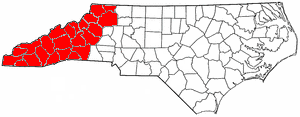
Western North Carolina is the region of North Carolina which includes the Appalachian Mountains; it is often known geographically as the state's Mountain Region. It contains the highest mountains in the Eastern United States, with 125 peaks rising to over 5,000 feet in elevation. Mount Mitchell at 6,684 feet, is the highest peak of the Appalachian Mountains and mainland eastern North America. The population of the 23 most commonly associated counties for the region, as measured by the 2020 U.S. Census, is 1,149,405. The region accounts for approximately 11% of North Carolina's total population.

Roan Mountain is a 6,285 ft (1,916 m) mountain straddling the North Carolina/Tennessee border in the Unaka Range of the Southern Appalachian Mountains in the Southeastern United States. The range's highpoint, Roan is clad in a dense stand of Southern Appalachian spruce-fir forest, and includes the world's largest natural rhododendron garden, and the longest stretch of grassy bald in the Appalachian range. The Roan Highlands also contain the highest quality remaining stretch of Fraser fir forest throughout the tree's entire range. The Cherokee National Forest and Pisgah National Forest converge atop the mountain, with Roan Mountain State Park located near its northern base. The Appalachian Trail traverses most of the Roan's crest. The Roan High Knob Shelter is the highest back-country shelter on the entire 2,174-mile (3,499 km) trail.
Zionville in an unincorporated community located in Watauga County, North Carolina. The community lies at the North Carolina/Tennessee state line, between Boone and Mountain City, along Old US Highway 421.
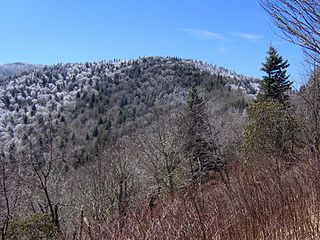
Old Black is a mountain in the Great Smoky Mountains, located in the Southeastern United States. While often overshadowed by Mount Guyot, its higher neighbor to the south, Old Black is the 5th-highest mountain in Tennessee and the 7th-highest in the Great Smoky Mountains National Park. The Appalachian Trail crosses its western slope, connecting the Cosby-area trail system with the heart of the eastern Smokies.
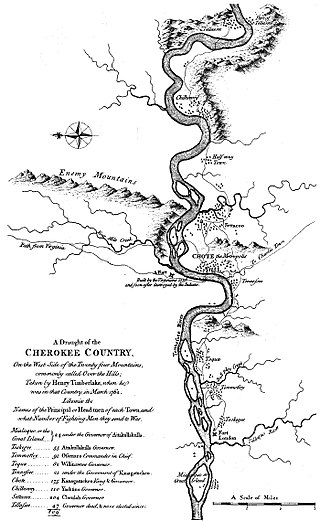
Overhill Cherokee was the term for the Cherokee people located in their historic settlements in what is now the U.S. state of Tennessee in the Southeastern United States, on the western side of the Appalachian Mountains. This name was used by 18th-century European traders and explorers from British colonies along the Atlantic coast, as they had to cross the mountains to reach these settlements.

Elk Knob State Park is a 4,423-acre (17.90 km2) North Carolina state park in Watauga County, North Carolina, in the United States. Opened in 2003, it is one of North Carolina's newest state parks. Elk Knob State Park was established to preserve the natural state of Elk Knob, the third highest peak in Watauga County. The park is open for year-round recreation and is currently undergoing an expansion of facilities to provide greater recreational opportunities to visitors. Elk Knob State Park is on Meat Camp Road, 5.5 miles (8.9 km) from North Carolina Highway 194, 9.5 miles (15.3 km) north of Boone, in the Blue Ridge Mountains.
Gilliam Banmon Grayson was an American old-time fiddle player and singer. Mostly blind from infancy, Grayson is chiefly remembered for a series of sides recorded with guitarist Henry Whitter between 1927 and 1930 that would later influence numerous country, bluegrass, and rock musicians. Grayson wrote much of his own material, but was also instrumental in adapting several traditional Appalachian ballads to fiddle and guitar formats. His music has been recorded or performed by musicians such as Bob Dylan, Doc Watson, Mick Jagger, the Kingston Trio, and dozens of bluegrass artists, including the Stanley Brothers and Mac Wiseman.

Wolf Laurel, North Carolina, is an unincorporated, private gated community, located in Madison and Yancey Counties of Western North Carolina. The unincorporated community is located approximately 30 miles north of Asheville, North Carolina, 6 miles from interstate 26 and borders the Cherokee National Forest, Tennessee state line and Appalachian Trail. It is named after Wolf Laurel Branch, which flows into Puncheon Fork after leaving the community upstream.
Ferguson is an unincorporated community in Wilkes County, North Carolina, United States. Ferguson is located on North Carolina Highway 268, 12.3 miles (19.8 km) west-southwest of Wilkesboro. Ferguson has a post office with ZIP code 28624.


















